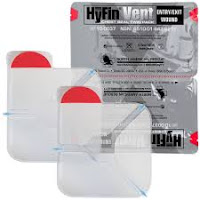IFAK
IFAK stands for Individual First Aid Kit. I did a previous post on assembling a first aid kit here. That was for the standard Scout first aid kit that is required for Tenderfoot rank and should be carried on all Scout outings. Although that kit has a few items in it that would come in handy in a real emergency, it is primarily a "boo-boo" kit for minor cuts and scrapes and such. The IFAK I want to talk about is designed for serious emergencies or "hurry cases" in Scout lingo. This is something to keep on or near you at all times, not just for Scout activities. If you are a student, keep it in your backpack. Public access bleeding control kits are a thing now. They are typically co-located with AED's. Familiarize yourself with the location of these at your school or workplace.
A good IFAK should allow you to do the following things: 1. protect yourself (gloves / CPR mask) 2. apply a tourniquet 3. apply a pressure dressing 4. pack a wound 5. treat a sucking chest wound 6. cut clothing and bandages
I will address each one of these criteria below with ideal, as well as thrifty or compact options. You might be thinking to yourself at this point, "I didn't learn how to do some of those things in my First Aid merit badge class." The BSA's first aid training, overall is pretty good. However, for whatever reason, they have not kept up with modern techniques of bleeding control. To bring yourself up to speed, you need to familiarize yourself with the Stop the Bleed campaign from the American College of Surgeons Committee on Trauma. This is an educational program for the public from the same organization that certifies trauma centers. Click here to watch a third party video that sums it up fairly well.
1. Protect yourself. At least one pair of nitrile gloves, preferably 2 pairs (sometimes they tear as you are putting them on). You can find these at the dollar store, pharmacy, auto parts store, big box store, or at Harbor Freight in small packages of 2-10 gloves. A full size CPR mask is nice, but a bit bulky for most people to carry around. A keychain style CPR mask is more practical. You can get these on eBay for about $2.
2. Tourniquet. There are 3 main tourniquets recommended by the organization that recommend such things (CoTCCC). The CAT, SOFTT-W, and SAM-XT. All of these run about $28. A thrifty alternative is a triangular bandage and a sturdy stick. Get an old sheet from home or a thrift store. Cut it into a 40" x 40" square. Then cut it on the diagonal to yield 2 triangular bandages. The second one can be used to secure the stick, or for a variety of other purposes. You can find a stick in the woods, or get a 3/8" oak dowel from the hardware store and cut it to 6".
3. Pressure dressing. The Isreali dressing is ideal for this purpose. You can also use 2 triangular bandages, or some 4x4 dressings and a 4" elastic (ACE) bandage.
4. Pack a wound. Hemostatic Quick Clot or Celox gauze are ideal for this, but cost $20+ and have an expiration date. The next best option is compressed Z fold gauze, which is less expensive and does not expire. Then there is regular 3" roller gauze, which is inexpensive and widely available.
5. Treat a sucking chest wound. There are a few different commercial products for this, like the HyFin chest seal, and the Halo chest seal. You can improvise with duct tape, which also has a million other uses. I recommend putting 24-36" of duct tape on an old credit card or similar card. Gorilla tape is the best.
6. Cut clothing a bandages. Trauma shears are ideal. Other alternatives include a pair of kids school scissors, or a letter opener.
You'll need a bag to keep it in. You can use a quart freezer bag, a cosmetic case or a zippered pencil case. See-through and water-proof are the qualities you want.
The most important piece of equipment is between your ears. The knowledge of what to do, and the mindset to do it are paramount. If you have the knowledge, you can improvise with whatever you have. Without the knowledge, the fanciest equipment will be useless. Scouting has a long history of responding to emergencies and saving lives. Be Prepared!
















Comments
Post a Comment